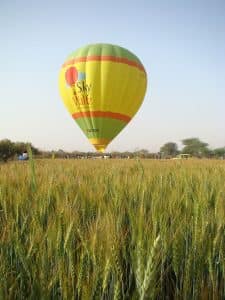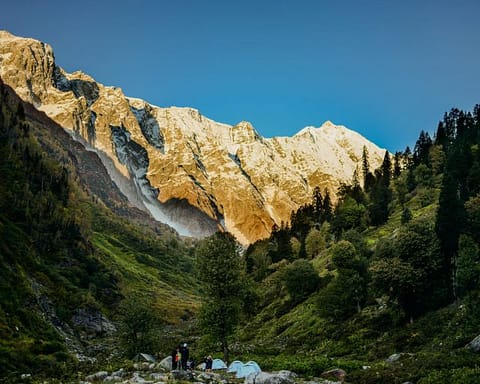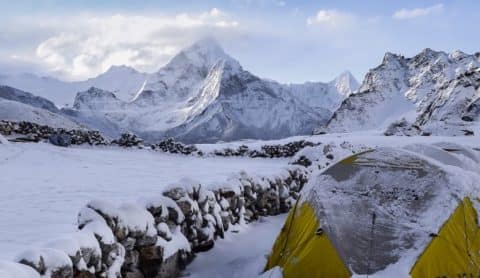vanika
Vanika Sumbly has graduated from Delhi University with a major in English Literature. She believes traveling is truly the best way of passively exploring oneself. And writing about it is active exploration.
Latest posts by vanika (see all)
Nature’s resplendent display of wonders peaks in the North-eastern region of India. With Tibet in the north and east, Bhutan on its east, Indian state West Bengal in the south and Nepal on its West, Sikkim is one of the most important tourist locations in the North-East. Almost 35 percent of it covered by Kanchenjunga National Park, this state is the least populous and the second smallest state in the country.
Trekking in Sikkim: Nature and Nurture
Although it is home to many tourist attractions, cultural festivals, and trekking summits due to its proximity to the Himalayas and unique flora and fauna, three treks stand out as the best options for exploring the Himalayas. Goecha La trek provides a majestic view of Kanchenjunga and allows for an intense expedition to explore it. Sandakphu trek offers a picturesque trail where the journey is as significant as the destination itself. Lastly, an excursion to Singalila provides close-up views of the Singalila range and the opportunity to spot rare wildlife in the Singalila National Park.
Here’s a complete breakdown of the three jewels of North-East:
Goecha La
Home to world’s highest mountains like Kanchenjunga, the trek to Goecha la is for those on the lookout for a trek that challenges them within and almost simultaneously delights them with the richness of natural beauty surrounding them. Exotic flora and fauna, alpine meadows, glacier basins, this place in Sikkim is a treasure trove for travelers curious to seek Nature’s wonders.

- Goecha la offers splendid views of world’s third highest mountain Kanchenjunga and Pandin, Tien Chenkhang, Koktang, Jopuno, etc.
- Discover the breathtaking stupas, monasteries, temples, and wildlife sanctuaries situated in the area.
- Explore your way through beautiful green fields, diverse plant and animal life, unique wildlife species, highland meadows, and icy glaciers until you reach your ultimate goal.
The sun begins to rise from Mt. Kanchenjunga in the early morning. - If you are fortunate, you may spot the Eurasian tree sparrow, pied bush cat, and green-tailed sunbird, and have the opportunity to witness the rare presence of endangered Himalayan species such as musk deer, red panda, and blue sheep at Kanchenjunga National Park.
- In Lamuney, walk through clouds and camp under the glittery sky at night
Sandakphu
The Sandakphu trek is an excellent choice for several reasons. Firstly, it provides unparalleled views of the world’s highest peaks, including Kanchenjunga, Everest, Lhotse, Nuptse, and the Annapurna range. Additionally, the journey to reach this destination on the map is filled with breathtaking natural wonders. Along the way, you will encounter dense forests, vast meadows, and the opportunity to trek alongside the Siri river. Whether you choose to stay in guest houses or camp, it is guaranteed to be a delightful experience. This trek offers a stunning retreat into nature, with forests, waterfalls, alpine meadows, and more.

Best season:During the spring season, the path to Sandakphu is adorned with beautiful rhododendrons and other unique plants, including the magnificent magnolia from Chitre to Meghma. However, the trek remains accessible even in winter, and the snowy trails possess their own enchanting appeal that matches the beauty of the destination.
- One of the most beautiful rhododendron treks; trek in Spring to behold the beauty with your own eyes as you make way to the Sandakphu summit
- Explore the vibrant Buddhist culture as you start your trek from Chitre village; pay a visit to the splendid monasteries and stupas around
Singalila National Park - Camping in Singalila National Park; enjoy the days of camping amid North East’s natural beauty; wake up to a sunrise on Singalila range and spot blue bamboos in the jungle!
A guest house in Tumling - Tumling’s guest houses set on the serene river bankside; Tumling lies on the Indo-Nepal border and houses many a beautiful tea estate in the region; you can look at the entire Sandakphu trail from the ascent after Tumling
Black Lake or Kalaphokri - Kalaphokri or ‘Black Lake’: After Tumling, reach the bean-shaped black lake that refuses to freeze even in deadly winters. Believed to be divine, the lake is surrounded by an array of Buddhist flags found fluttering in the wind.
- Magnificent view of Sleeping Buddha (Kanchenjunga and sister peaks) and a 180 degree view of world’s highest mountains including Everest, Makalu, Lhotse, Nuptse, Baruntse, Chamling, Chomolonzo, Machapucchare, Chomolhari and other peaks of Annapurna range.
Singalila Pass (and Phoktey Dara trek)
The Singalila range is located on the western borders of Sikkim and Darjeeling, adjacent to Nepal. There is an amazing opportunity to go on a trek through the passes and ranges that are present in both India and Nepal. After reaching Singalila pass, you can continue your trek to Kalijhora. At the top of Kalijhora is Phoktey Dara, which provides a breathtaking view. On the far left (west) side, you can see the magnificent Everest group of peaks, and on the right side, there are three sisters – Chamlang, Baruntse, Kanchendzongha, Simvo, Pandim, and Tenzingkhang – all lined up one after another. The entire Kabru range (North, South, Dome), Fork I/II, Rathong, and Frey peak (located just above Chaurikhang in the HMI base camp area) are situated to the south of the enormous Kanchenjunga and form a semicircle in front of it.

Best season:The optimal times to embark on a journey through the Singalila range are during the months of March to May and October to November.
- Panoramic views of four of the five world’s highest peaks including Mt. Everest, Kanchenjunga, Lhotse and Makalu and more
- The Singalila range is located on the border between India and Nepal, specifically serving as the western borders of Sikkim and Darjeeling with Nepal.
- Visit Kitam Bird Sanctuary and Barsey Rhododendron Sanctuary to spot the Red Crossbill and Parrotbills. If you are lucky, you might spot the endangered vividly colored Satyr Tragopan or a Kalij Pheasant as well!
- Walk through rich forests canopied by rhododendron, magnolia and bamboo
- Witness spellbinding sunrise at Kalijohra
- Spend your evenings at stunning campsites located near a densely forested hill slope adorned with Magnolia trees and conifers.
- Experience the exclusivity of accessing remote locations with very low population density.
Trekking in the North-east is a growing interest of the young trekkers for it offers an exclusive opportunity to witness distinct culture, communities located in remote locations however so incredibly beautiful, that it makes the trekking experience wholesome and worth it.










